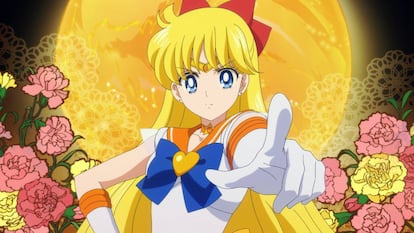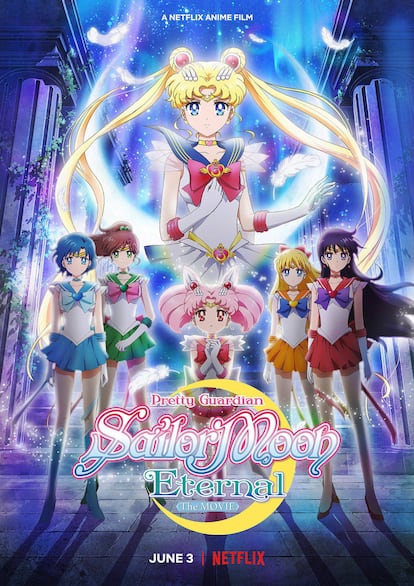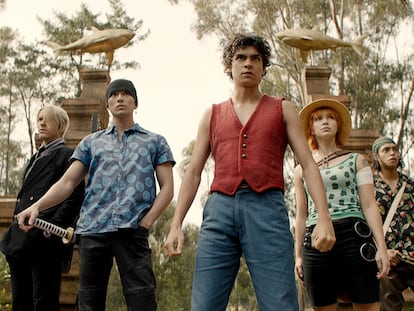The return of ‘Sailor Moon’: How and why the warrior in pigtails and a miniskirt who confronted the forces of evil has been resurrected
Naoko Takeuchi’s anime introduced its followers to new concepts like sisterhood. Now, Rosalía and Karol G are not letting the show’s legacy die

In Rosalía’s Relación (remix) music video, she wears the iconic hairstyle of two high buns with parted bangs and a few straight ponytails that slide down her back. For those familiar with the character Sailor Moon from the anime of the same name, it is difficult not to see the similarities. Naoko Takeuchi’s animation, which began airing in Japan in 1992, did not reach Spanish television screens until the end of the following year. That gave rise to the popularity of the young Usagi Tsukino — the main character’s first name — and her warrior companions, the Sailor Senshi, among Spanish teenagers. These characters all starred in a story in which they lead a double life characterized by magical powers, cosmic forces and a mission to protect the solar system from the threats of those who sought to annihilate it.
Rosalía is not the only one who has given a nod to Sailor Moon in recent years. Many pop-culture and fashion personalities have been inspired by the anime show, from its most adorable looks to its most controversial side: “Many people find an escape from reality in these types of characters,” says MLMA (@melovemealot), a visual artist and the co-founder and designer of Korean streetwear brand Skoot Apparel, a leader in including anime in fashion; MLMA has outfitted celebrities like Billie Eilish and Rosalía herself.
In addition to the fantasy and escape from reality, another powerful element, identification with the main character, helps explain Sailor Moon’s success and impact on pop culture: “There is a Japanese term, moe, which means something like blossoming, and it is used to describe how anime fans affectively relate to fictional characters instead of seeking a grand narrative. I think the current resurgence of certain styles and characters, like Usagi Tsukino, in pop culture is connected to the moe phenomenon. The emotional attachment to fictional characters is transformed into culture and aesthetics,” explains Alba Torrents, a PhD in philosophy, anime specialist and professor of gender theory at the Universitat Autònoma de Barcelona.
Indeed, this colorful fantasy universe replete with mythological references, iconography, celestial attributes and chattering kittens is much more than an aesthetic icon. The series provided a comfort zone to enjoy seeing women’s power and strength represented, both individually and collectively. It also depicted the value of unconditional friendship, sisterhood and the existence of a diversity of identities and sexual orientations, among many other issues that had not been particularly visible on television until then.
Providing role models where there were none
Among the phrases that could be heard on the show were “These days only old men think that men are better than women” and “I don’t like men who don’t understand women’s feelings!” This anime series broke with the template of a female accompanying a man on important missions, usually in a secondary, not leading, role. “In this context, Sailor Moon stood out because, beyond the romantic plot, it focused on a story that had essentially developed in the context of mostly male protagonists and productions for eminently male audiences: the struggle of the forces of good versus the forces of evil, regardless of how these are represented,” explains Daniel Ferrera López, a PhD in Media Research who specializes in gender studies and whose thesis focused on Japanese anime.
While the female character is the one who has the real capacity to finish off the enemy, in each episode the male character — the protagonist’s love interest — usually appears to rescue her. However, in Sailor Moon, such involvement is perceived in a more critical and even humorous way. Daniel Ferrera offers the example of the famous meme in which he states, “My work here is done,” and she replies, “but you haven’t done anything.”
“A show intended for children and young audiences that moves away from that normative center is highly relevant. [That’s] not only because of the appearance of LGTBIQ+ characters, but also because femininities and masculinities move away from such tight constraints as well,” Ferrera says.

Sailor Moon was also a pioneering animated series with its inclusion of the issue of sisterhood; all the members of the group are necessary and have an essential role to play to protect the peace. They value and appreciate each other with all their faults and virtues, as do the members of a true group of friends who understand that they can live and survive better together. Moreover, Sailor Moon started the subgenre of magical girls, that is, a group of girls who have an ordinary life and become heroines, allowing for an effect similar to the one the Spice Girls had: each character has a very clear personality and attributes that are different from those of the other team members, so it is very easy to recognize oneself in one or more of them.
Why Sailor Moon has aged so well
Another reason why Sailor Moon has aged so well is its inclusion of plots and characters that feature non-normative or LGTBI+ identities: “Sailor Moon is ahead of its time in respectively and positively handling sexual diversity. For example, the other characters fully accept Haruka and her partner Michiru without denying or undermining their gender identity or their romantic relationship. This dignified, non-stigmatizing treatment is a milestone in the history of anime, and it reinforces the argument that these characters can be much more than the reiteration of heteronormative stereotypes,” Alba Torrents observes.
Despite all these advances, it is worth remembering that the series premiered in 1991. Feminism is more developed today and seeks to avoid repeating certain patterns in Sailor Moon: “While the main characters are young teenagers — a symbol of purity — the female enemies are clichéd characters who use their sexuality as a weapon. The dichotomy between good and evil is structured around ‘good’ and ‘bad’ femininity,” Daniel Ferrera notes.
Countless collaborations
The influence of Japanese anime and culture is evident in the careers, style and personal tastes of many artists like Rosalía, as can be seen in the visual and narrative storytelling on her Motomami album and her latest track Tuya. But the Spanish singer is not the only one who has given a nod to the anime show. The presence of these ‘90s space warriors is still relevant today in many places: in iconic outfits like the one Billie Eilish wore to the 2019 IRadio Music Awards; some of Karol G.’s styles; a lot of merchandising; TikTok videos by users like Ella Cheng, who recreate the show’s style; themed collections by luxury brands; reinterpretations of the show’s main character by artists like Ricardo Cavolo, who is known for incorporating pop culture characters into his work; and designers like MLMA: “I was naturally inspired to escape reality and exist in another society. As an anime fan, I think the concept developed because I made designs with which my friends identified,” the artist and designer says of how Sailor Moon influenced the successful Skoot Apparel, her artwork and herself.
Millennials who decorated their high school binders with the series’ characters are not the only ones to adopt this imaginary; new generations appreciate it as well. It is not a coincidence that a series that had such progressive values for its time with regard to feminism, non-normative identities and the LGTBI+ community also permeates Generation Z’s aesthetic universe, both in real life and in fiction with characters like Jules (Hunter Schafer) in Euphoria (created by Sam Levinson), a trans girl whose style is heavily influenced by this anime — it is bright, feminine, colorful and striking — and often directly recalls the Sailor Moon character. As MLMA explains, that once again represents an escape from reality. Moreover, it makes sense that Jules — and not someone else — dresses so fancifully since the attire functions as an escape from the negativity and sorrows that Rue’s (Zendaya) dark, complicated life entails.
In the music video for Relación (remix), Rosalía appears in Usagi Tsukino’s hairstyle. The song itself speaks of a woman who overcomes her circumstances and decides to prioritize herself and look out for her well-being, let go of what hurts her — in this case, an abusive relationship and a heartbreaking romantic breakup — and embrace her authenticity and her being. In other words, Rosalía sings as the archetype of the warrior woman embodied by the Sailor Guardians, who continue to shine somewhere in the celestial vault.

Sign up for our weekly newsletter to get more English-language news coverage from EL PAÍS USA Edition
More information









































